Legal and General: Communication Gap in Cultural Diversity Research
VerifiedAdded on 2023/01/11
|11
|2661
|44
Project
AI Summary
This research project investigates the issues arising from communication gaps in managing cultural diversity within a workplace setting, specifically focusing on Legal and General. The project includes a research proposal defining the research question and objectives, followed by a literature review exploring the influence of communication gaps on organizational performance and strategies for minimizing these gaps. The methodology section outlines the research philosophy (positivism), approach (deductive), and choice (quantitative), along with data collection methods, including questionnaires completed by 50 respondents, and secondary sources. The project also addresses ethical considerations and employs analytical tools like content analysis to interpret the quantitative data obtained. The research presents a questionnaire and data analysis, exploring topics such as the benefits of cultural diversity, issues arising at the workplace, strategies for managing cultural diversity, and the impact of communication gaps on organizational performance. The findings provide insights into the reasons behind communication gaps, the impact on the company, and potential solutions for improvement, culminating in a comprehensive analysis of the research topic.
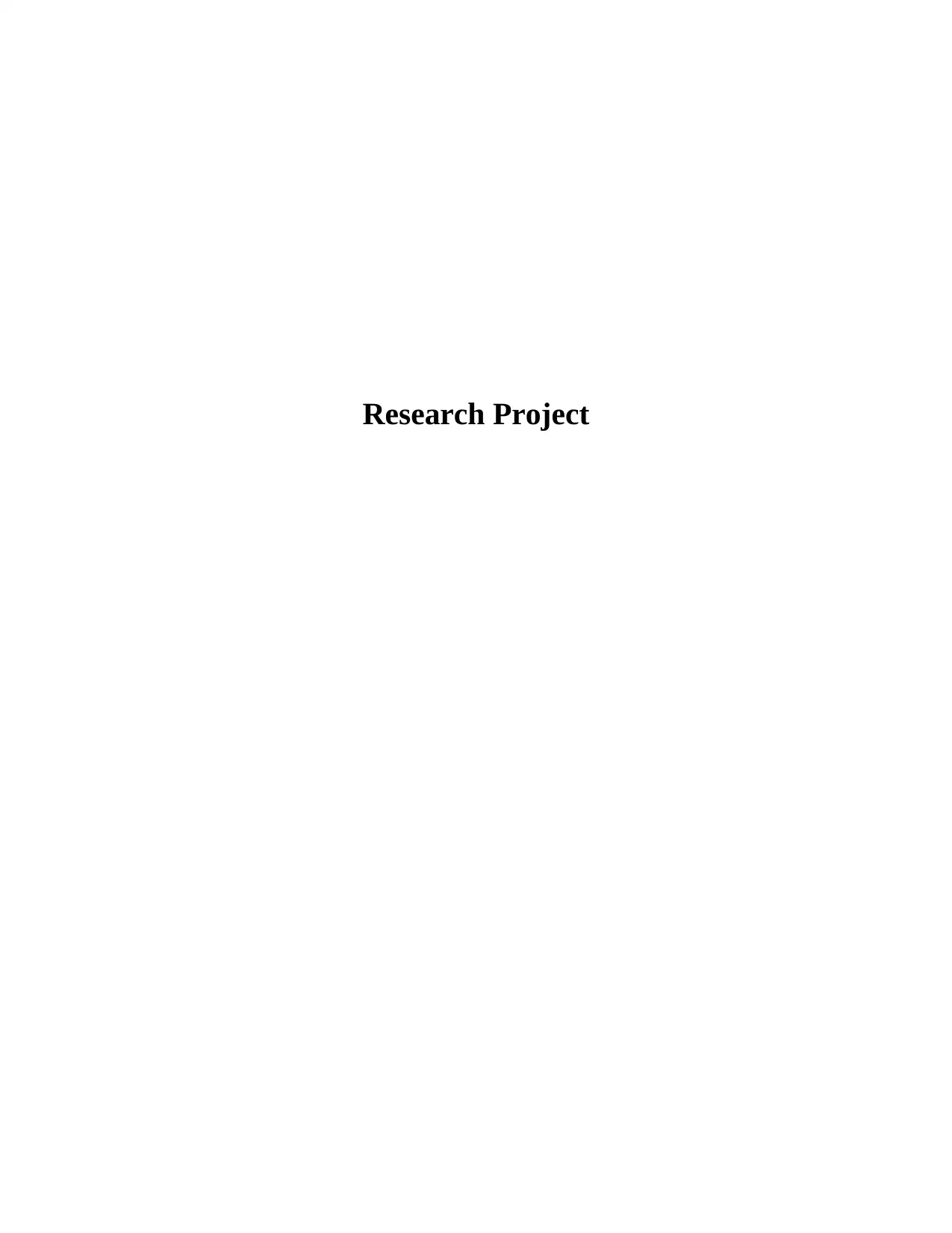
Research Project
Paraphrase This Document
Need a fresh take? Get an instant paraphrase of this document with our AI Paraphraser
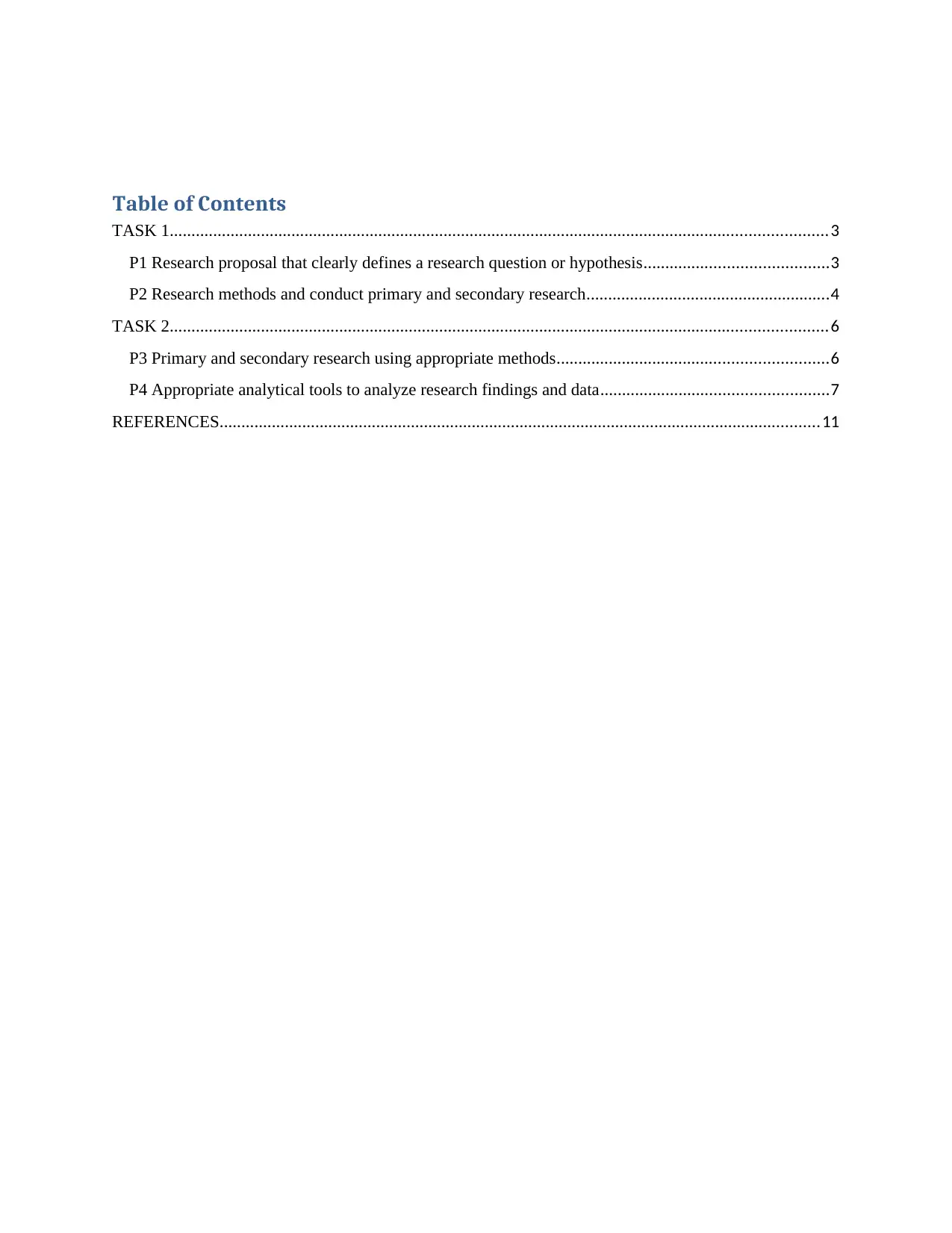
Table of Contents
TASK 1.......................................................................................................................................................3
P1 Research proposal that clearly defines a research question or hypothesis..........................................3
P2 Research methods and conduct primary and secondary research........................................................4
TASK 2.......................................................................................................................................................6
P3 Primary and secondary research using appropriate methods..............................................................6
P4 Appropriate analytical tools to analyze research findings and data....................................................7
REFERENCES..........................................................................................................................................11
TASK 1.......................................................................................................................................................3
P1 Research proposal that clearly defines a research question or hypothesis..........................................3
P2 Research methods and conduct primary and secondary research........................................................4
TASK 2.......................................................................................................................................................6
P3 Primary and secondary research using appropriate methods..............................................................6
P4 Appropriate analytical tools to analyze research findings and data....................................................7
REFERENCES..........................................................................................................................................11
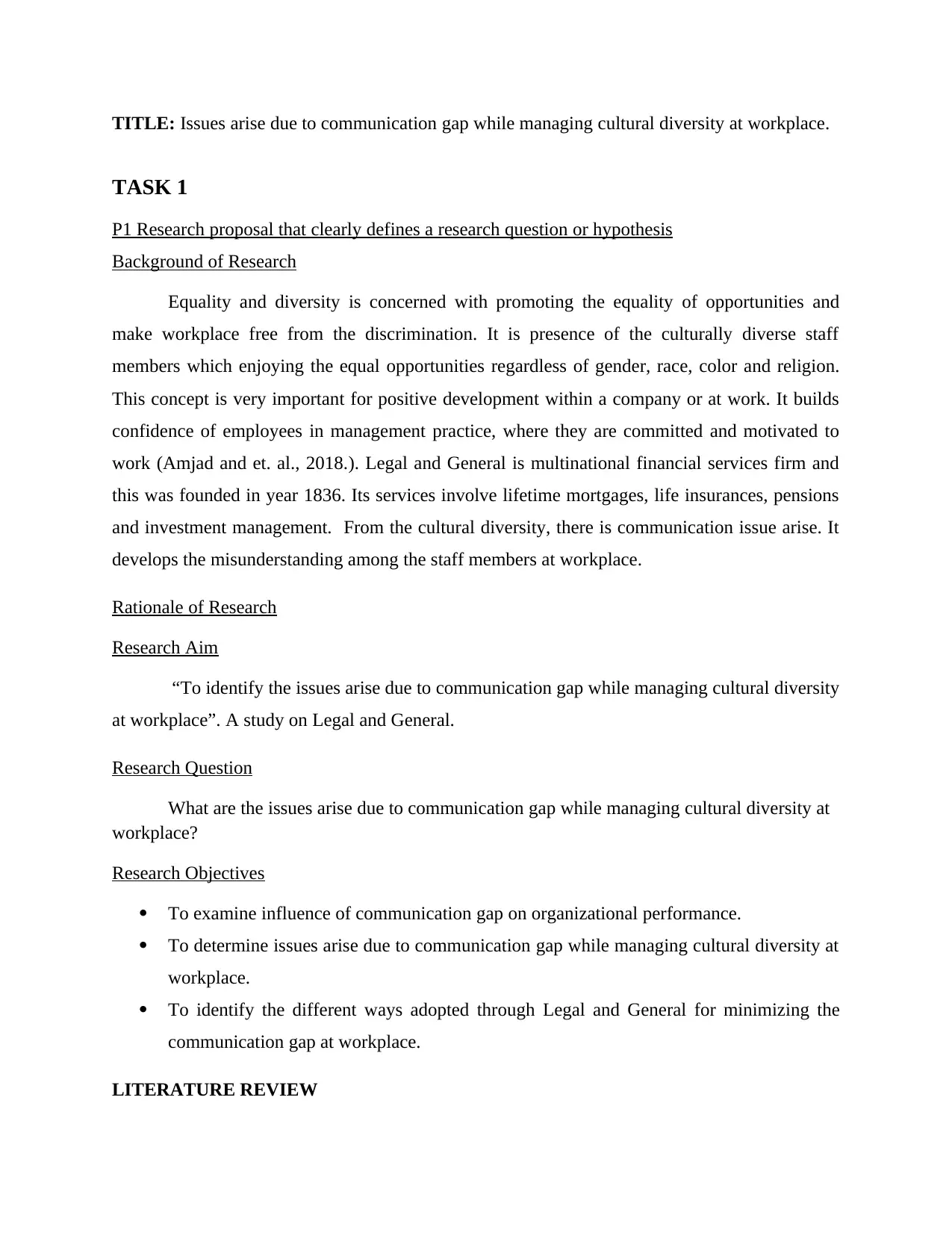
TITLE: Issues arise due to communication gap while managing cultural diversity at workplace.
TASK 1
P1 Research proposal that clearly defines a research question or hypothesis
Background of Research
Equality and diversity is concerned with promoting the equality of opportunities and
make workplace free from the discrimination. It is presence of the culturally diverse staff
members which enjoying the equal opportunities regardless of gender, race, color and religion.
This concept is very important for positive development within a company or at work. It builds
confidence of employees in management practice, where they are committed and motivated to
work (Amjad and et. al., 2018.). Legal and General is multinational financial services firm and
this was founded in year 1836. Its services involve lifetime mortgages, life insurances, pensions
and investment management. From the cultural diversity, there is communication issue arise. It
develops the misunderstanding among the staff members at workplace.
Rationale of Research
Research Aim
“To identify the issues arise due to communication gap while managing cultural diversity
at workplace”. A study on Legal and General.
Research Question
What are the issues arise due to communication gap while managing cultural diversity at
workplace?
Research Objectives
To examine influence of communication gap on organizational performance.
To determine issues arise due to communication gap while managing cultural diversity at
workplace.
To identify the different ways adopted through Legal and General for minimizing the
communication gap at workplace.
LITERATURE REVIEW
TASK 1
P1 Research proposal that clearly defines a research question or hypothesis
Background of Research
Equality and diversity is concerned with promoting the equality of opportunities and
make workplace free from the discrimination. It is presence of the culturally diverse staff
members which enjoying the equal opportunities regardless of gender, race, color and religion.
This concept is very important for positive development within a company or at work. It builds
confidence of employees in management practice, where they are committed and motivated to
work (Amjad and et. al., 2018.). Legal and General is multinational financial services firm and
this was founded in year 1836. Its services involve lifetime mortgages, life insurances, pensions
and investment management. From the cultural diversity, there is communication issue arise. It
develops the misunderstanding among the staff members at workplace.
Rationale of Research
Research Aim
“To identify the issues arise due to communication gap while managing cultural diversity
at workplace”. A study on Legal and General.
Research Question
What are the issues arise due to communication gap while managing cultural diversity at
workplace?
Research Objectives
To examine influence of communication gap on organizational performance.
To determine issues arise due to communication gap while managing cultural diversity at
workplace.
To identify the different ways adopted through Legal and General for minimizing the
communication gap at workplace.
LITERATURE REVIEW
⊘ This is a preview!⊘
Do you want full access?
Subscribe today to unlock all pages.

Trusted by 1+ million students worldwide
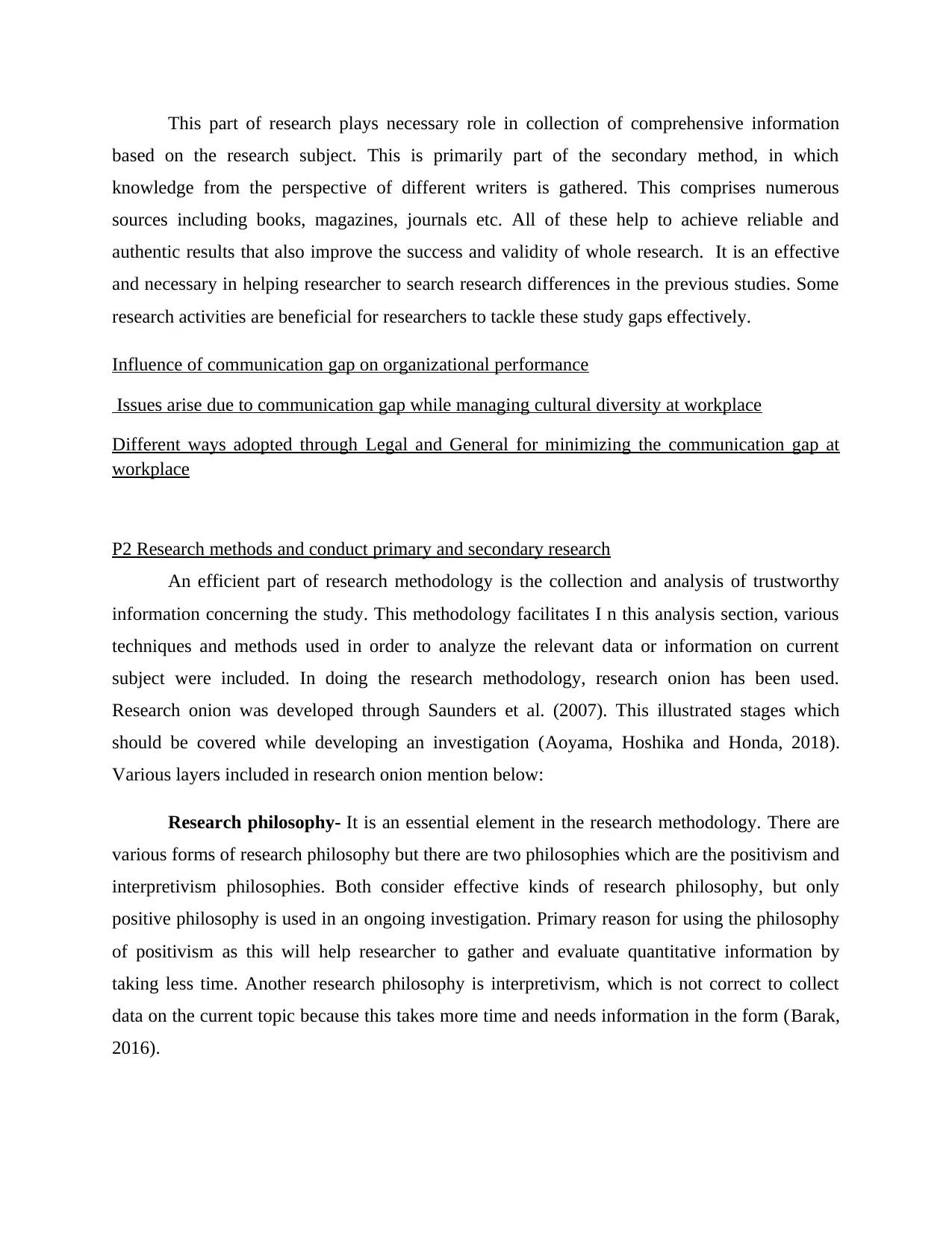
This part of research plays necessary role in collection of comprehensive information
based on the research subject. This is primarily part of the secondary method, in which
knowledge from the perspective of different writers is gathered. This comprises numerous
sources including books, magazines, journals etc. All of these help to achieve reliable and
authentic results that also improve the success and validity of whole research. It is an effective
and necessary in helping researcher to search research differences in the previous studies. Some
research activities are beneficial for researchers to tackle these study gaps effectively.
Influence of communication gap on organizational performance
Issues arise due to communication gap while managing cultural diversity at workplace
Different ways adopted through Legal and General for minimizing the communication gap at
workplace
P2 Research methods and conduct primary and secondary research
An efficient part of research methodology is the collection and analysis of trustworthy
information concerning the study. This methodology facilitates I n this analysis section, various
techniques and methods used in order to analyze the relevant data or information on current
subject were included. In doing the research methodology, research onion has been used.
Research onion was developed through Saunders et al. (2007). This illustrated stages which
should be covered while developing an investigation (Aoyama, Hoshika and Honda, 2018).
Various layers included in research onion mention below:
Research philosophy- It is an essential element in the research methodology. There are
various forms of research philosophy but there are two philosophies which are the positivism and
interpretivism philosophies. Both consider effective kinds of research philosophy, but only
positive philosophy is used in an ongoing investigation. Primary reason for using the philosophy
of positivism as this will help researcher to gather and evaluate quantitative information by
taking less time. Another research philosophy is interpretivism, which is not correct to collect
data on the current topic because this takes more time and needs information in the form (Barak,
2016).
based on the research subject. This is primarily part of the secondary method, in which
knowledge from the perspective of different writers is gathered. This comprises numerous
sources including books, magazines, journals etc. All of these help to achieve reliable and
authentic results that also improve the success and validity of whole research. It is an effective
and necessary in helping researcher to search research differences in the previous studies. Some
research activities are beneficial for researchers to tackle these study gaps effectively.
Influence of communication gap on organizational performance
Issues arise due to communication gap while managing cultural diversity at workplace
Different ways adopted through Legal and General for minimizing the communication gap at
workplace
P2 Research methods and conduct primary and secondary research
An efficient part of research methodology is the collection and analysis of trustworthy
information concerning the study. This methodology facilitates I n this analysis section, various
techniques and methods used in order to analyze the relevant data or information on current
subject were included. In doing the research methodology, research onion has been used.
Research onion was developed through Saunders et al. (2007). This illustrated stages which
should be covered while developing an investigation (Aoyama, Hoshika and Honda, 2018).
Various layers included in research onion mention below:
Research philosophy- It is an essential element in the research methodology. There are
various forms of research philosophy but there are two philosophies which are the positivism and
interpretivism philosophies. Both consider effective kinds of research philosophy, but only
positive philosophy is used in an ongoing investigation. Primary reason for using the philosophy
of positivism as this will help researcher to gather and evaluate quantitative information by
taking less time. Another research philosophy is interpretivism, which is not correct to collect
data on the current topic because this takes more time and needs information in the form (Barak,
2016).
Paraphrase This Document
Need a fresh take? Get an instant paraphrase of this document with our AI Paraphraser
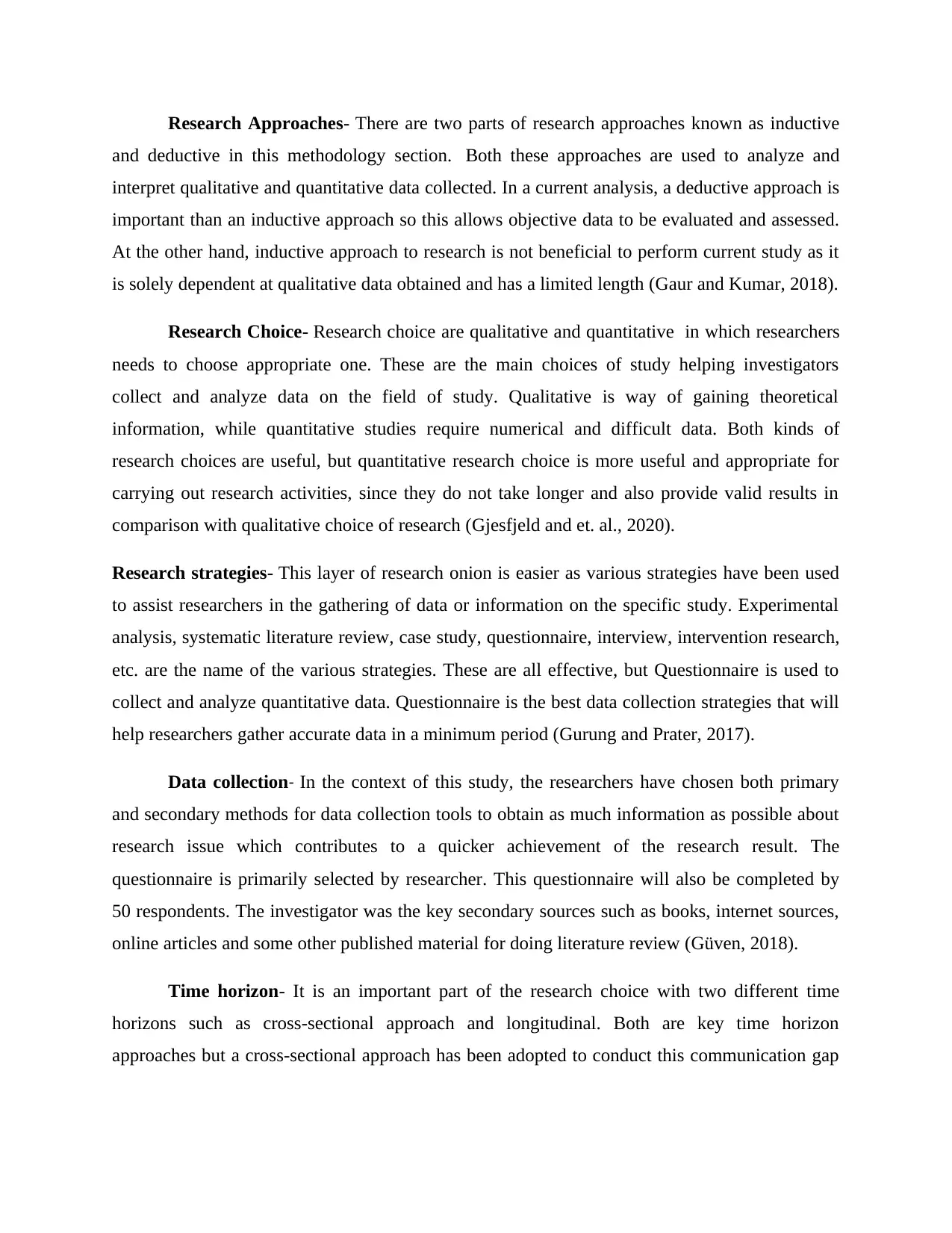
Research Approaches- There are two parts of research approaches known as inductive
and deductive in this methodology section. Both these approaches are used to analyze and
interpret qualitative and quantitative data collected. In a current analysis, a deductive approach is
important than an inductive approach so this allows objective data to be evaluated and assessed.
At the other hand, inductive approach to research is not beneficial to perform current study as it
is solely dependent at qualitative data obtained and has a limited length (Gaur and Kumar, 2018).
Research Choice- Research choice are qualitative and quantitative in which researchers
needs to choose appropriate one. These are the main choices of study helping investigators
collect and analyze data on the field of study. Qualitative is way of gaining theoretical
information, while quantitative studies require numerical and difficult data. Both kinds of
research choices are useful, but quantitative research choice is more useful and appropriate for
carrying out research activities, since they do not take longer and also provide valid results in
comparison with qualitative choice of research (Gjesfjeld and et. al., 2020).
Research strategies- This layer of research onion is easier as various strategies have been used
to assist researchers in the gathering of data or information on the specific study. Experimental
analysis, systematic literature review, case study, questionnaire, interview, intervention research,
etc. are the name of the various strategies. These are all effective, but Questionnaire is used to
collect and analyze quantitative data. Questionnaire is the best data collection strategies that will
help researchers gather accurate data in a minimum period (Gurung and Prater, 2017).
Data collection- In the context of this study, the researchers have chosen both primary
and secondary methods for data collection tools to obtain as much information as possible about
research issue which contributes to a quicker achievement of the research result. The
questionnaire is primarily selected by researcher. This questionnaire will also be completed by
50 respondents. The investigator was the key secondary sources such as books, internet sources,
online articles and some other published material for doing literature review (Güven, 2018).
Time horizon- It is an important part of the research choice with two different time
horizons such as cross-sectional approach and longitudinal. Both are key time horizon
approaches but a cross-sectional approach has been adopted to conduct this communication gap
and deductive in this methodology section. Both these approaches are used to analyze and
interpret qualitative and quantitative data collected. In a current analysis, a deductive approach is
important than an inductive approach so this allows objective data to be evaluated and assessed.
At the other hand, inductive approach to research is not beneficial to perform current study as it
is solely dependent at qualitative data obtained and has a limited length (Gaur and Kumar, 2018).
Research Choice- Research choice are qualitative and quantitative in which researchers
needs to choose appropriate one. These are the main choices of study helping investigators
collect and analyze data on the field of study. Qualitative is way of gaining theoretical
information, while quantitative studies require numerical and difficult data. Both kinds of
research choices are useful, but quantitative research choice is more useful and appropriate for
carrying out research activities, since they do not take longer and also provide valid results in
comparison with qualitative choice of research (Gjesfjeld and et. al., 2020).
Research strategies- This layer of research onion is easier as various strategies have been used
to assist researchers in the gathering of data or information on the specific study. Experimental
analysis, systematic literature review, case study, questionnaire, interview, intervention research,
etc. are the name of the various strategies. These are all effective, but Questionnaire is used to
collect and analyze quantitative data. Questionnaire is the best data collection strategies that will
help researchers gather accurate data in a minimum period (Gurung and Prater, 2017).
Data collection- In the context of this study, the researchers have chosen both primary
and secondary methods for data collection tools to obtain as much information as possible about
research issue which contributes to a quicker achievement of the research result. The
questionnaire is primarily selected by researcher. This questionnaire will also be completed by
50 respondents. The investigator was the key secondary sources such as books, internet sources,
online articles and some other published material for doing literature review (Güven, 2018).
Time horizon- It is an important part of the research choice with two different time
horizons such as cross-sectional approach and longitudinal. Both are key time horizon
approaches but a cross-sectional approach has been adopted to conduct this communication gap
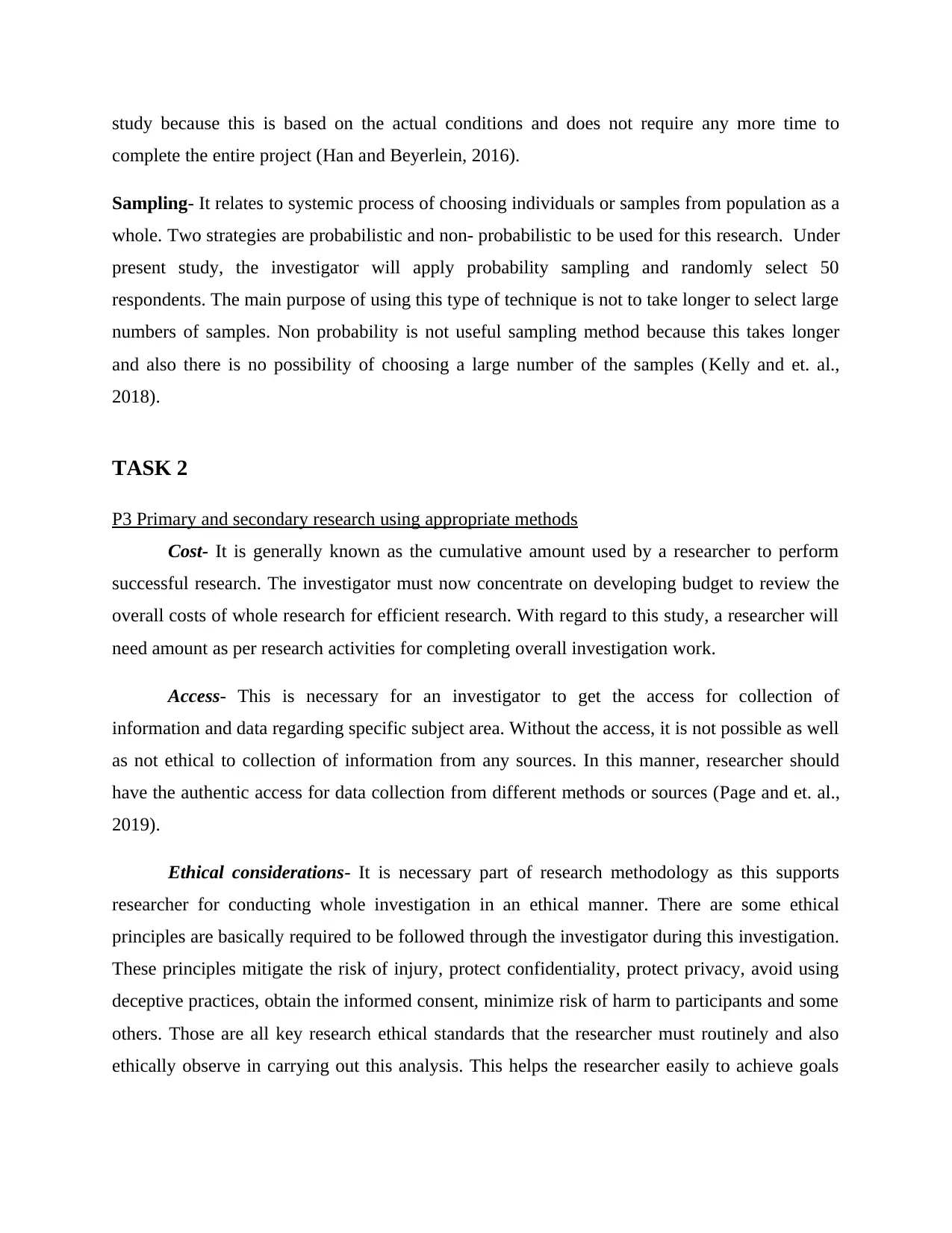
study because this is based on the actual conditions and does not require any more time to
complete the entire project (Han and Beyerlein, 2016).
Sampling- It relates to systemic process of choosing individuals or samples from population as a
whole. Two strategies are probabilistic and non- probabilistic to be used for this research. Under
present study, the investigator will apply probability sampling and randomly select 50
respondents. The main purpose of using this type of technique is not to take longer to select large
numbers of samples. Non probability is not useful sampling method because this takes longer
and also there is no possibility of choosing a large number of the samples (Kelly and et. al.,
2018).
TASK 2
P3 Primary and secondary research using appropriate methods
Cost- It is generally known as the cumulative amount used by a researcher to perform
successful research. The investigator must now concentrate on developing budget to review the
overall costs of whole research for efficient research. With regard to this study, a researcher will
need amount as per research activities for completing overall investigation work.
Access- This is necessary for an investigator to get the access for collection of
information and data regarding specific subject area. Without the access, it is not possible as well
as not ethical to collection of information from any sources. In this manner, researcher should
have the authentic access for data collection from different methods or sources (Page and et. al.,
2019).
Ethical considerations- It is necessary part of research methodology as this supports
researcher for conducting whole investigation in an ethical manner. There are some ethical
principles are basically required to be followed through the investigator during this investigation.
These principles mitigate the risk of injury, protect confidentiality, protect privacy, avoid using
deceptive practices, obtain the informed consent, minimize risk of harm to participants and some
others. Those are all key research ethical standards that the researcher must routinely and also
ethically observe in carrying out this analysis. This helps the researcher easily to achieve goals
complete the entire project (Han and Beyerlein, 2016).
Sampling- It relates to systemic process of choosing individuals or samples from population as a
whole. Two strategies are probabilistic and non- probabilistic to be used for this research. Under
present study, the investigator will apply probability sampling and randomly select 50
respondents. The main purpose of using this type of technique is not to take longer to select large
numbers of samples. Non probability is not useful sampling method because this takes longer
and also there is no possibility of choosing a large number of the samples (Kelly and et. al.,
2018).
TASK 2
P3 Primary and secondary research using appropriate methods
Cost- It is generally known as the cumulative amount used by a researcher to perform
successful research. The investigator must now concentrate on developing budget to review the
overall costs of whole research for efficient research. With regard to this study, a researcher will
need amount as per research activities for completing overall investigation work.
Access- This is necessary for an investigator to get the access for collection of
information and data regarding specific subject area. Without the access, it is not possible as well
as not ethical to collection of information from any sources. In this manner, researcher should
have the authentic access for data collection from different methods or sources (Page and et. al.,
2019).
Ethical considerations- It is necessary part of research methodology as this supports
researcher for conducting whole investigation in an ethical manner. There are some ethical
principles are basically required to be followed through the investigator during this investigation.
These principles mitigate the risk of injury, protect confidentiality, protect privacy, avoid using
deceptive practices, obtain the informed consent, minimize risk of harm to participants and some
others. Those are all key research ethical standards that the researcher must routinely and also
ethically observe in carrying out this analysis. This helps the researcher easily to achieve goals
⊘ This is a preview!⊘
Do you want full access?
Subscribe today to unlock all pages.

Trusted by 1+ million students worldwide
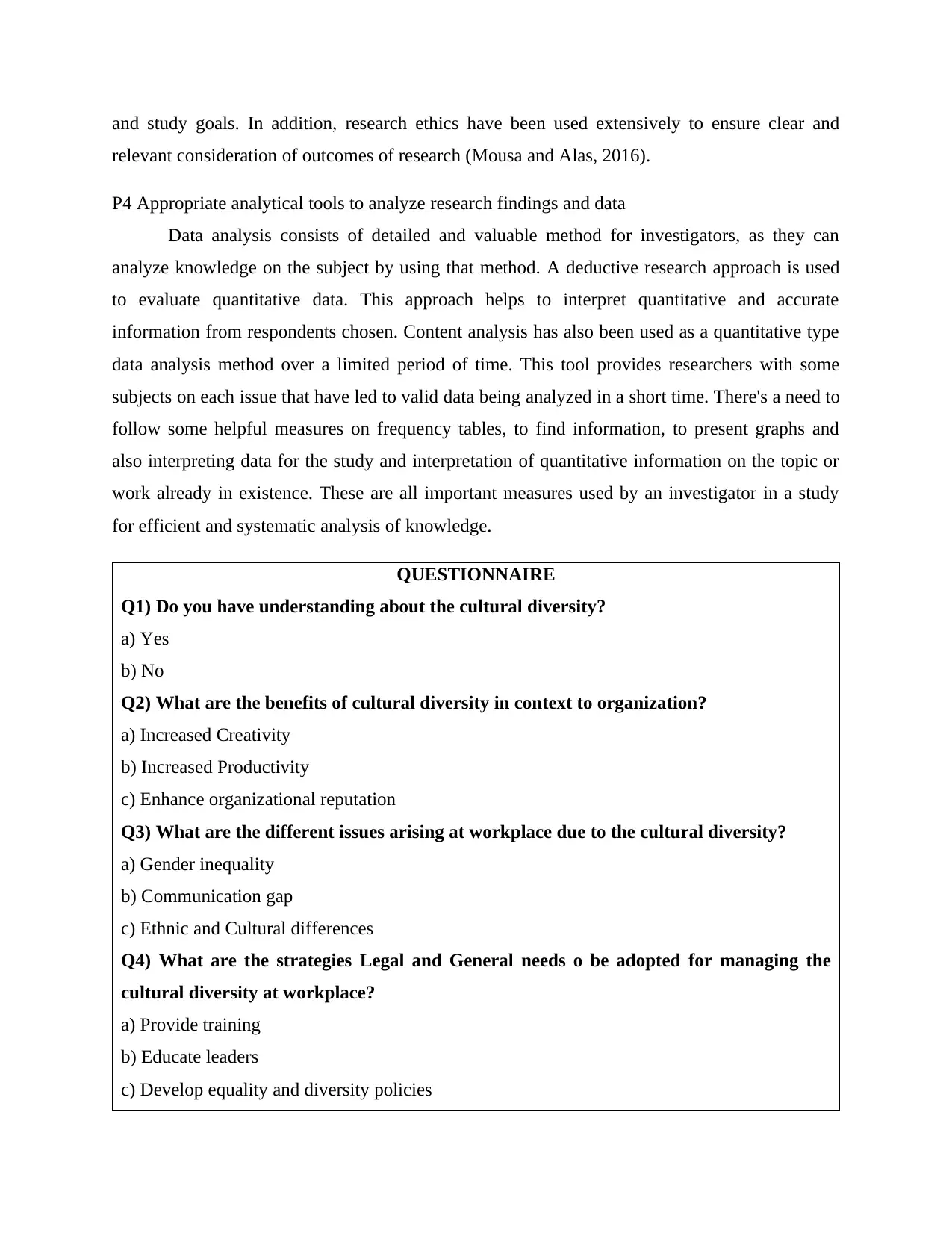
and study goals. In addition, research ethics have been used extensively to ensure clear and
relevant consideration of outcomes of research (Mousa and Alas, 2016).
P4 Appropriate analytical tools to analyze research findings and data
Data analysis consists of detailed and valuable method for investigators, as they can
analyze knowledge on the subject by using that method. A deductive research approach is used
to evaluate quantitative data. This approach helps to interpret quantitative and accurate
information from respondents chosen. Content analysis has also been used as a quantitative type
data analysis method over a limited period of time. This tool provides researchers with some
subjects on each issue that have led to valid data being analyzed in a short time. There's a need to
follow some helpful measures on frequency tables, to find information, to present graphs and
also interpreting data for the study and interpretation of quantitative information on the topic or
work already in existence. These are all important measures used by an investigator in a study
for efficient and systematic analysis of knowledge.
QUESTIONNAIRE
Q1) Do you have understanding about the cultural diversity?
a) Yes
b) No
Q2) What are the benefits of cultural diversity in context to organization?
a) Increased Creativity
b) Increased Productivity
c) Enhance organizational reputation
Q3) What are the different issues arising at workplace due to the cultural diversity?
a) Gender inequality
b) Communication gap
c) Ethnic and Cultural differences
Q4) What are the strategies Legal and General needs o be adopted for managing the
cultural diversity at workplace?
a) Provide training
b) Educate leaders
c) Develop equality and diversity policies
relevant consideration of outcomes of research (Mousa and Alas, 2016).
P4 Appropriate analytical tools to analyze research findings and data
Data analysis consists of detailed and valuable method for investigators, as they can
analyze knowledge on the subject by using that method. A deductive research approach is used
to evaluate quantitative data. This approach helps to interpret quantitative and accurate
information from respondents chosen. Content analysis has also been used as a quantitative type
data analysis method over a limited period of time. This tool provides researchers with some
subjects on each issue that have led to valid data being analyzed in a short time. There's a need to
follow some helpful measures on frequency tables, to find information, to present graphs and
also interpreting data for the study and interpretation of quantitative information on the topic or
work already in existence. These are all important measures used by an investigator in a study
for efficient and systematic analysis of knowledge.
QUESTIONNAIRE
Q1) Do you have understanding about the cultural diversity?
a) Yes
b) No
Q2) What are the benefits of cultural diversity in context to organization?
a) Increased Creativity
b) Increased Productivity
c) Enhance organizational reputation
Q3) What are the different issues arising at workplace due to the cultural diversity?
a) Gender inequality
b) Communication gap
c) Ethnic and Cultural differences
Q4) What are the strategies Legal and General needs o be adopted for managing the
cultural diversity at workplace?
a) Provide training
b) Educate leaders
c) Develop equality and diversity policies
Paraphrase This Document
Need a fresh take? Get an instant paraphrase of this document with our AI Paraphraser
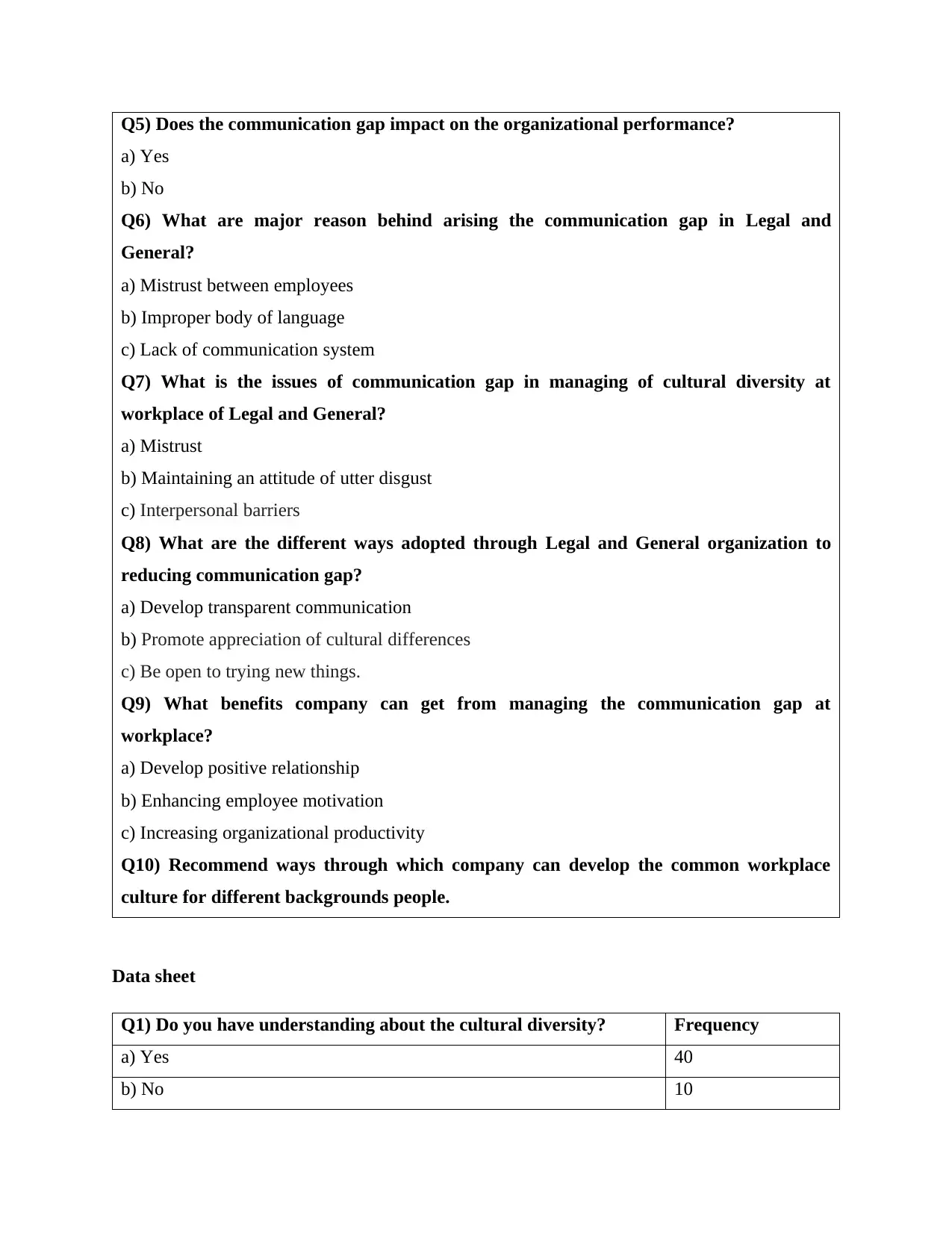
Q5) Does the communication gap impact on the organizational performance?
a) Yes
b) No
Q6) What are major reason behind arising the communication gap in Legal and
General?
a) Mistrust between employees
b) Improper body of language
c) Lack of communication system
Q7) What is the issues of communication gap in managing of cultural diversity at
workplace of Legal and General?
a) Mistrust
b) Maintaining an attitude of utter disgust
c) Interpersonal barriers
Q8) What are the different ways adopted through Legal and General organization to
reducing communication gap?
a) Develop transparent communication
b) Promote appreciation of cultural differences
c) Be open to trying new things.
Q9) What benefits company can get from managing the communication gap at
workplace?
a) Develop positive relationship
b) Enhancing employee motivation
c) Increasing organizational productivity
Q10) Recommend ways through which company can develop the common workplace
culture for different backgrounds people.
Data sheet
Q1) Do you have understanding about the cultural diversity? Frequency
a) Yes 40
b) No 10
a) Yes
b) No
Q6) What are major reason behind arising the communication gap in Legal and
General?
a) Mistrust between employees
b) Improper body of language
c) Lack of communication system
Q7) What is the issues of communication gap in managing of cultural diversity at
workplace of Legal and General?
a) Mistrust
b) Maintaining an attitude of utter disgust
c) Interpersonal barriers
Q8) What are the different ways adopted through Legal and General organization to
reducing communication gap?
a) Develop transparent communication
b) Promote appreciation of cultural differences
c) Be open to trying new things.
Q9) What benefits company can get from managing the communication gap at
workplace?
a) Develop positive relationship
b) Enhancing employee motivation
c) Increasing organizational productivity
Q10) Recommend ways through which company can develop the common workplace
culture for different backgrounds people.
Data sheet
Q1) Do you have understanding about the cultural diversity? Frequency
a) Yes 40
b) No 10
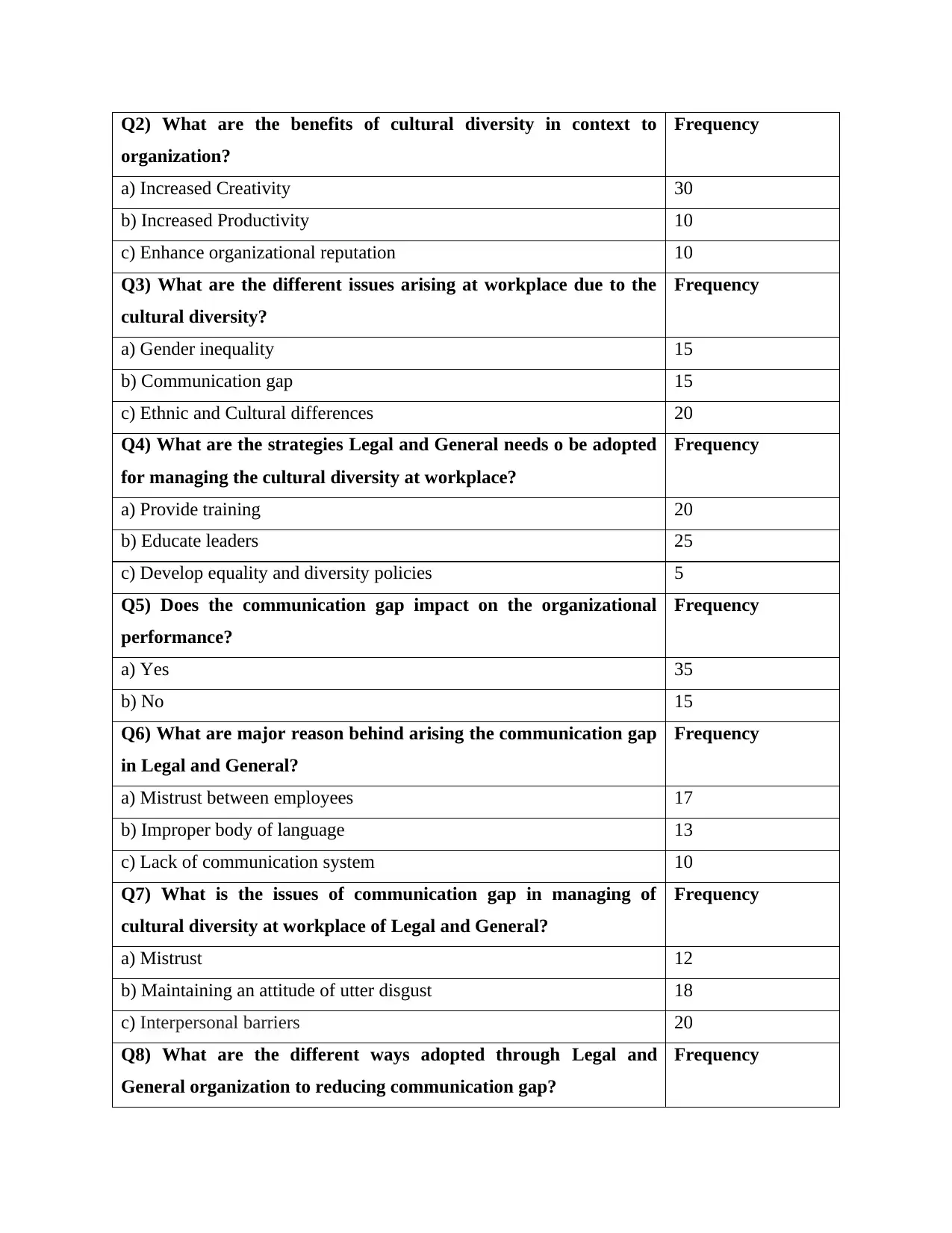
Q2) What are the benefits of cultural diversity in context to
organization?
Frequency
a) Increased Creativity 30
b) Increased Productivity 10
c) Enhance organizational reputation 10
Q3) What are the different issues arising at workplace due to the
cultural diversity?
Frequency
a) Gender inequality 15
b) Communication gap 15
c) Ethnic and Cultural differences 20
Q4) What are the strategies Legal and General needs o be adopted
for managing the cultural diversity at workplace?
Frequency
a) Provide training 20
b) Educate leaders 25
c) Develop equality and diversity policies 5
Q5) Does the communication gap impact on the organizational
performance?
Frequency
a) Yes 35
b) No 15
Q6) What are major reason behind arising the communication gap
in Legal and General?
Frequency
a) Mistrust between employees 17
b) Improper body of language 13
c) Lack of communication system 10
Q7) What is the issues of communication gap in managing of
cultural diversity at workplace of Legal and General?
Frequency
a) Mistrust 12
b) Maintaining an attitude of utter disgust 18
c) Interpersonal barriers 20
Q8) What are the different ways adopted through Legal and
General organization to reducing communication gap?
Frequency
organization?
Frequency
a) Increased Creativity 30
b) Increased Productivity 10
c) Enhance organizational reputation 10
Q3) What are the different issues arising at workplace due to the
cultural diversity?
Frequency
a) Gender inequality 15
b) Communication gap 15
c) Ethnic and Cultural differences 20
Q4) What are the strategies Legal and General needs o be adopted
for managing the cultural diversity at workplace?
Frequency
a) Provide training 20
b) Educate leaders 25
c) Develop equality and diversity policies 5
Q5) Does the communication gap impact on the organizational
performance?
Frequency
a) Yes 35
b) No 15
Q6) What are major reason behind arising the communication gap
in Legal and General?
Frequency
a) Mistrust between employees 17
b) Improper body of language 13
c) Lack of communication system 10
Q7) What is the issues of communication gap in managing of
cultural diversity at workplace of Legal and General?
Frequency
a) Mistrust 12
b) Maintaining an attitude of utter disgust 18
c) Interpersonal barriers 20
Q8) What are the different ways adopted through Legal and
General organization to reducing communication gap?
Frequency
⊘ This is a preview!⊘
Do you want full access?
Subscribe today to unlock all pages.

Trusted by 1+ million students worldwide
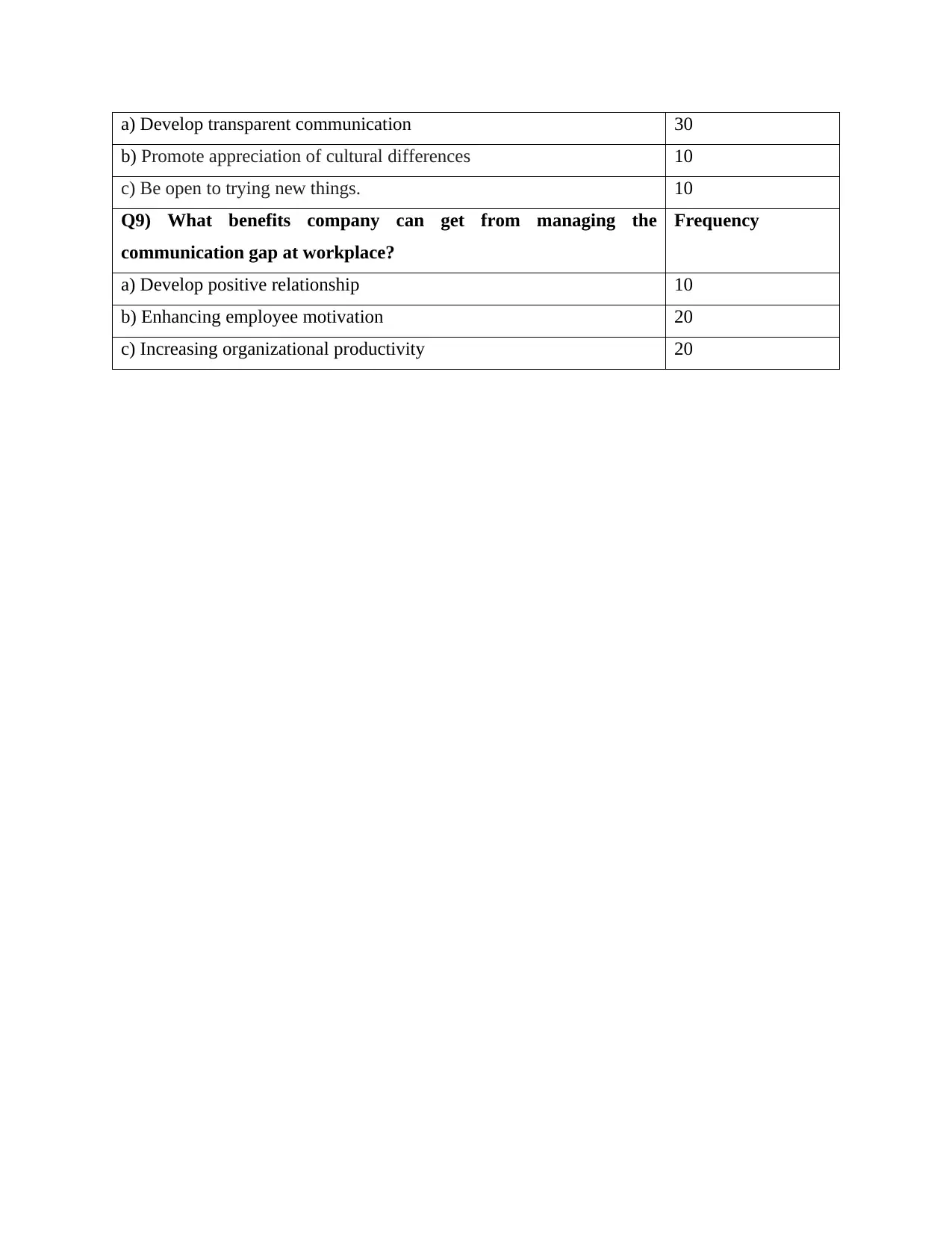
a) Develop transparent communication 30
b) Promote appreciation of cultural differences 10
c) Be open to trying new things. 10
Q9) What benefits company can get from managing the
communication gap at workplace?
Frequency
a) Develop positive relationship 10
b) Enhancing employee motivation 20
c) Increasing organizational productivity 20
b) Promote appreciation of cultural differences 10
c) Be open to trying new things. 10
Q9) What benefits company can get from managing the
communication gap at workplace?
Frequency
a) Develop positive relationship 10
b) Enhancing employee motivation 20
c) Increasing organizational productivity 20
Paraphrase This Document
Need a fresh take? Get an instant paraphrase of this document with our AI Paraphraser
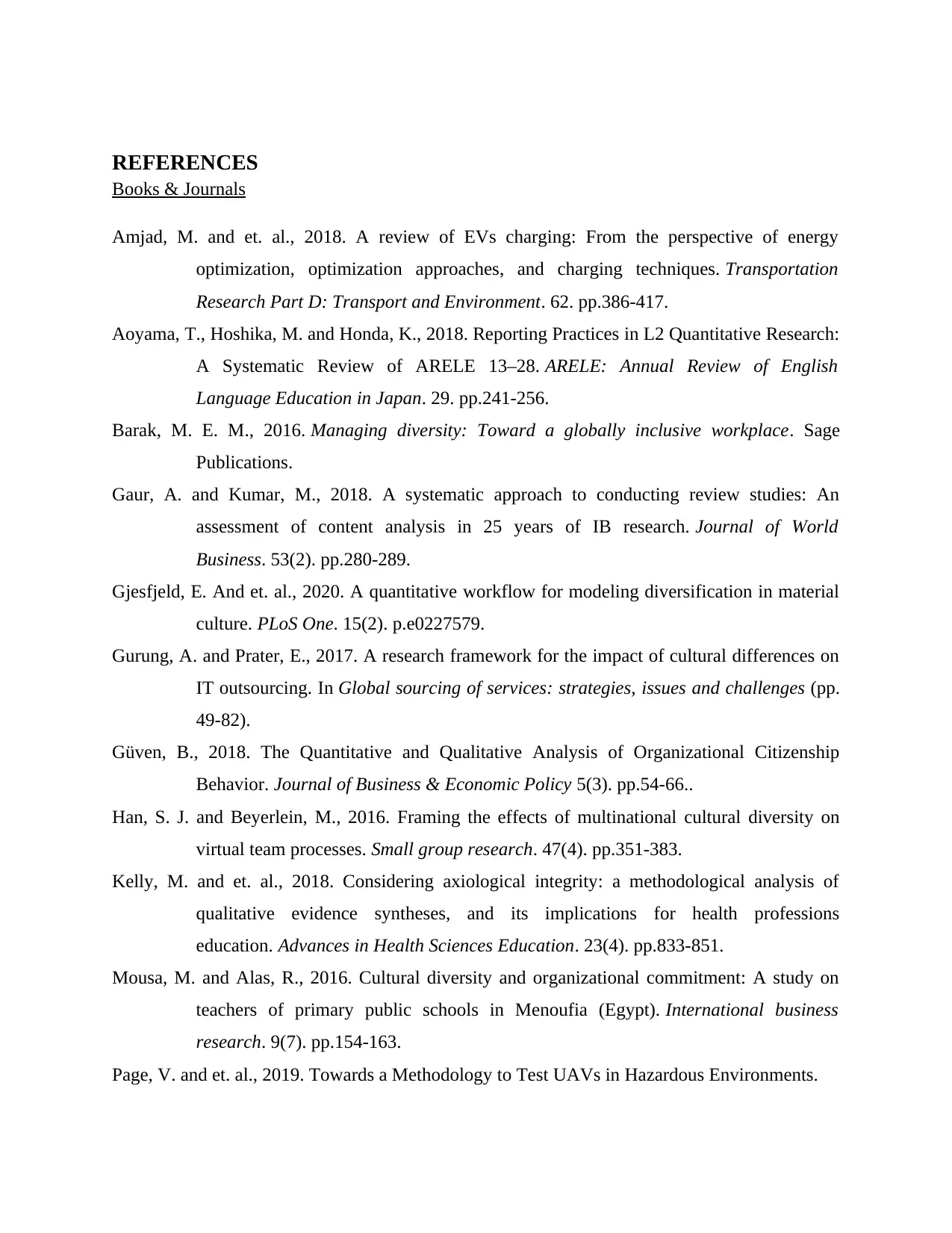
REFERENCES
Books & Journals
Amjad, M. and et. al., 2018. A review of EVs charging: From the perspective of energy
optimization, optimization approaches, and charging techniques. Transportation
Research Part D: Transport and Environment. 62. pp.386-417.
Aoyama, T., Hoshika, M. and Honda, K., 2018. Reporting Practices in L2 Quantitative Research:
A Systematic Review of ARELE 13–28. ARELE: Annual Review of English
Language Education in Japan. 29. pp.241-256.
Barak, M. E. M., 2016. Managing diversity: Toward a globally inclusive workplace. Sage
Publications.
Gaur, A. and Kumar, M., 2018. A systematic approach to conducting review studies: An
assessment of content analysis in 25 years of IB research. Journal of World
Business. 53(2). pp.280-289.
Gjesfjeld, E. And et. al., 2020. A quantitative workflow for modeling diversification in material
culture. PLoS One. 15(2). p.e0227579.
Gurung, A. and Prater, E., 2017. A research framework for the impact of cultural differences on
IT outsourcing. In Global sourcing of services: strategies, issues and challenges (pp.
49-82).
Güven, B., 2018. The Quantitative and Qualitative Analysis of Organizational Citizenship
Behavior. Journal of Business & Economic Policy 5(3). pp.54-66..
Han, S. J. and Beyerlein, M., 2016. Framing the effects of multinational cultural diversity on
virtual team processes. Small group research. 47(4). pp.351-383.
Kelly, M. and et. al., 2018. Considering axiological integrity: a methodological analysis of
qualitative evidence syntheses, and its implications for health professions
education. Advances in Health Sciences Education. 23(4). pp.833-851.
Mousa, M. and Alas, R., 2016. Cultural diversity and organizational commitment: A study on
teachers of primary public schools in Menoufia (Egypt). International business
research. 9(7). pp.154-163.
Page, V. and et. al., 2019. Towards a Methodology to Test UAVs in Hazardous Environments.
Books & Journals
Amjad, M. and et. al., 2018. A review of EVs charging: From the perspective of energy
optimization, optimization approaches, and charging techniques. Transportation
Research Part D: Transport and Environment. 62. pp.386-417.
Aoyama, T., Hoshika, M. and Honda, K., 2018. Reporting Practices in L2 Quantitative Research:
A Systematic Review of ARELE 13–28. ARELE: Annual Review of English
Language Education in Japan. 29. pp.241-256.
Barak, M. E. M., 2016. Managing diversity: Toward a globally inclusive workplace. Sage
Publications.
Gaur, A. and Kumar, M., 2018. A systematic approach to conducting review studies: An
assessment of content analysis in 25 years of IB research. Journal of World
Business. 53(2). pp.280-289.
Gjesfjeld, E. And et. al., 2020. A quantitative workflow for modeling diversification in material
culture. PLoS One. 15(2). p.e0227579.
Gurung, A. and Prater, E., 2017. A research framework for the impact of cultural differences on
IT outsourcing. In Global sourcing of services: strategies, issues and challenges (pp.
49-82).
Güven, B., 2018. The Quantitative and Qualitative Analysis of Organizational Citizenship
Behavior. Journal of Business & Economic Policy 5(3). pp.54-66..
Han, S. J. and Beyerlein, M., 2016. Framing the effects of multinational cultural diversity on
virtual team processes. Small group research. 47(4). pp.351-383.
Kelly, M. and et. al., 2018. Considering axiological integrity: a methodological analysis of
qualitative evidence syntheses, and its implications for health professions
education. Advances in Health Sciences Education. 23(4). pp.833-851.
Mousa, M. and Alas, R., 2016. Cultural diversity and organizational commitment: A study on
teachers of primary public schools in Menoufia (Egypt). International business
research. 9(7). pp.154-163.
Page, V. and et. al., 2019. Towards a Methodology to Test UAVs in Hazardous Environments.
1 out of 11
Related Documents
Your All-in-One AI-Powered Toolkit for Academic Success.
+13062052269
info@desklib.com
Available 24*7 on WhatsApp / Email
![[object Object]](/_next/static/media/star-bottom.7253800d.svg)
Unlock your academic potential
Copyright © 2020–2025 A2Z Services. All Rights Reserved. Developed and managed by ZUCOL.





